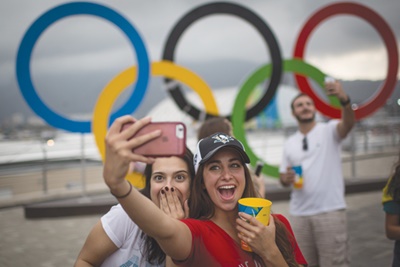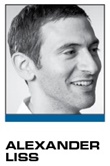L ooking back at the 2016 Olympics, it’s no surprise that the biggest winners in athletic performance were also the biggest winners in social media.
Our agency looked at the social activity around the Games using content analysis platform CrowdTangle and found that athletes drove the greatest spikes in social engagement. Usain Bolt, Simone Biles and Neymar were social rock stars during the Games. But not all athlete buzz was positive: Australian Mack Horton, gold-medal winner in the men’s 400m freestyle, ignited controversy by criticizing Chinese swimmer Sun Yang for failing a doping test in 2014. A massive backlash of negative comments on Horton’s celebratory Instagram and Facebook posts showed that athletes who invite controversy will quickly elicit negative reactions on social media — a fact not lost on Ryan Lochte.
What might surprise you, from a marketing perspective, is that on-site in Rio, the greatest volume of social sharing was driven by fan experiences away from the athletic events.
Using the location-specific social analysis tool GroundSignal, we found that of 374,000 posts in Rio using hashtag #Rio2016, only 14 percent (52,000 posts) were related to moments of athletic competition. The other 86 percent were centered on moments in the fan experience including exploring the city, interacting with brands and traveling to and from venues.
Some marketers who understood the power of experience scored some points themselves in Rio, and there are several success stories that represent the elements of a brand experience done right. By delivering authentic value for fans, these brands became a natural part of social discussions.
In terms of crafting the best experiences, the lessons were:
 |
The five-ring signage at Barra Olympic Park was a must-share moment at the Rio Games.
Photo by: GETTY IMAGES
|
■
Make it shareable
Experience: Five-ring signage at the entrance to Barra Olympic Park
The biggest winner in driving social posting was the host city and the sporting venues that hosted the games. Of the 374,000 social media posts originating in Rio tagged #Rio2016, 23 percent (84,000 posts) originated from Barra Olympic Park, and of these, the vast majority were selfies taken in front of the Olympic rings signage at the park entrance. The massive volume of social posts indicates a pattern of fan behavior at live events: the “plant the flag moment” when someone snaps a selfie as they walk through the door.
Lesson: If you want to drive social posting from venue attendees, create a must-share moment by co-opting (or building your own) landmarks in recognizable locations.
■ Make it communal
Experience: Parada Coca-Cola
No brand drove more social posting from Rio during the Games than Coca-Cola, driving 25 percent of all brand-specific mentions on-site during the Games. The Parada Coca-Cola experience featured a variety of activities to reinforce the communal spirit of the Games including multiple photo booth-like creation stations where groups of fans created their own images and posted them to social, including animated GIFs, torch-bearing videos and a mosaic of faces. The activities were also designed to appeal to teens and millennials, providing a flood of user-created content that the Coca-Cola team could share on owned channels to drive amplification at scale.
Lesson: By tying their experience to the communal nature of the Games, Coca-Cola created a collaborative atmosphere that drove social sharing.
■ Make it convenient
Experience: NBA fan experience on Boulevard Olímpico
NBA House drove 20 percent of all brand-specific mentions. Aside from having multiple levels of activities, a bar and a music space, it was also conveniently located in downtown Rio near the Boulevard Olímpico — a transportation hub — and close to the city’s newly opened monorail. It was in a logistically convenient place for people wandering the city. Additionally, both NBA House and Parada Coca-Cola were specifically designed to target fans without tickets as an alternative way to experience the Games.
Lesson: Be aware of timing and ease of the experience. Brand activations that struggled to drive social sharing were located in front of venues, where fans did not have extra time to explore a brand experience.
■ Make it exciting
Experience: Nissan bungee jump #QuemSeAtreve (#ThoseWhoDare)
Nissan’s bungee jump experience drove 10 percent of brand-specific mentions by providing fans with a different view of the Games, literally. Nissan set up a 40-meter-high crane in downtown Rio near Boulevard Olímpico, achieved high foot traffic and drew long lines every morning before it opened. (Disclosure: Momentum supported this effort.)
Lesson: Provide the visceral rush of competing in the Games without the hassle of training for them.
■ Celebrate the message
Experience: Graffiti wall on Boulevard Olímpico
One of the most shared images of the city, with 11,000 earned posts, was the 3,000-square-meter mural created by Brazilian graffiti artist Eduardo Kobra near Boulevard Olímpico. Commissioned by the city in time for the start of the Games, the work was called “Etnias,” or “Ethnicities,” and showed indigenous faces from five continents to reinforce the message of the Games highlighting diversity and inclusivity.
Lesson: Align your activation elements with the broader message of the event to drive social sharing.
Whether you’re training your brand for the next Games, or looking to make stronger everyday connections between people and brands, use the power of experience to get people talking.
Alexander Liss, vice president, director of analytics, at Momentum Worldwide since 2015, has helped numerous clients leverage brand experience to create customer intimacy through data connection and outreach. Follow him on Twitter @aliss77777.





